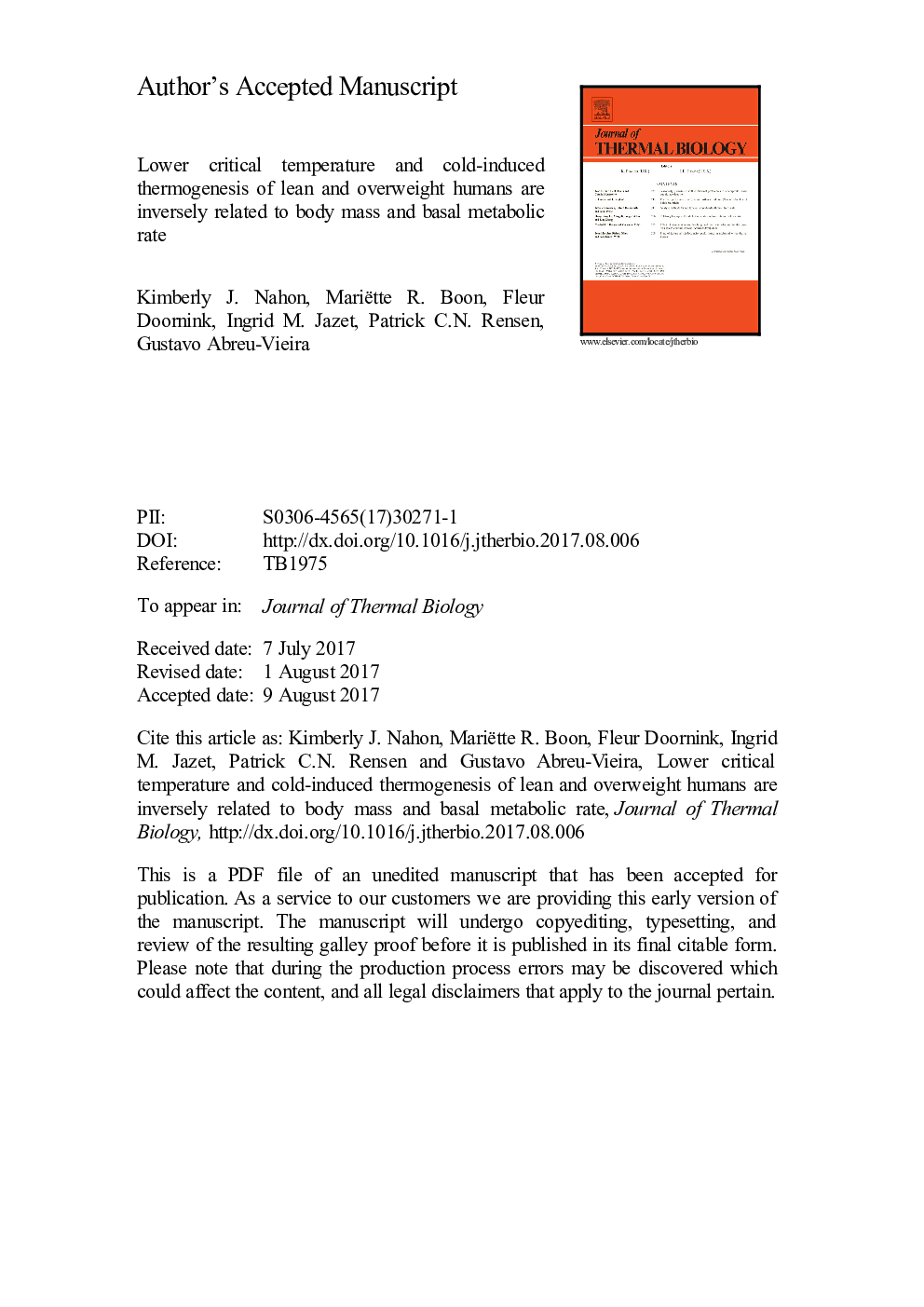| کد مقاله | کد نشریه | سال انتشار | مقاله انگلیسی | نسخه تمام متن |
|---|---|---|---|---|
| 5593360 | 1571079 | 2017 | 25 صفحه PDF | دانلود رایگان |
عنوان انگلیسی مقاله ISI
Lower critical temperature and cold-induced thermogenesis of lean and overweight humans are inversely related to body mass and basal metabolic rate
ترجمه فارسی عنوان
دمای بحرانی پایین تر و ترموژنز ناشی از سرما افراد مبتلا به وزن بدون چربی و اضافه وزن به طور معکوس با توده بدن و میزان متابولیسم پایه
دانلود مقاله + سفارش ترجمه
دانلود مقاله ISI انگلیسی
رایگان برای ایرانیان
کلمات کلیدی
موضوعات مرتبط
علوم زیستی و بیوفناوری
علوم کشاورزی و بیولوژیک
علوم کشاورزی و بیولوژیک (عمومی)
چکیده انگلیسی
It is colloquially stated that body size plays a role in the human response to cold, but the magnitude and details of this interaction are unclear. To explore the inherent influence of body size on cold-exposed metabolism, we investigated the relation between body composition and resting metabolic rate in humans at thermoneutrality and during cooling within the nonshivering thermogenesis range. Body composition and resting energy expenditure were measured in 20 lean and 20 overweight men at thermoneutrality and during individualized cold exposure. Metabolic rates as a function of ambient temperature were investigated considering the variability in body mass and composition. We observed an inverse relationship between body size and the lower critical temperature (LCT), i.e. the threshold where thermoneutrality ends and cold activates thermogenesis. LCT was higher in lean than overweight subjects (22.1 ± 0.6 vs 19.5 ± 0.5 °C, p < 0.001). Below LCT, minimum conductance was identical between lean and overweight (100 ± 4 vs 97 ± 3 kcal/°C/day respectively, p = 0.45). Overweight individuals had higher basal metabolic rate (BMR) explained mostly by the higher lean mass, and lower cold-induced thermogenesis (CIT) per degree of cold exposure. Below thermoneutrality, energy expenditure did not scale to lean body mass. Overweight subjects had lower heat loss per body surface area (44.7 ± 1.3 vs 54.7 ± 2.3 kcal/°C/m2/day, p < 0.001). We conclude that larger body sizes possessed reduced LCT as explained by higher BMR related to more lean mass rather than a change in whole-body conductance. Thus, larger individuals with higher lean mass need to be exposed to colder temperatures to activate CIT, not because of increased insulation, but because of a higher basal heat generation. Our study suggests that the distinct effects of body size and composition on energy expenditure should be taken in account when exploring the metabolism of humans exposed to cold.
ناشر
Database: Elsevier - ScienceDirect (ساینس دایرکت)
Journal: Journal of Thermal Biology - Volume 69, October 2017, Pages 238-248
Journal: Journal of Thermal Biology - Volume 69, October 2017, Pages 238-248
نویسندگان
Kimberly J. Nahon, Mariëtte R. Boon, Fleur Doornink, Ingrid M. Jazet, Patrick C.N. Rensen, Gustavo Abreu-Vieira,
